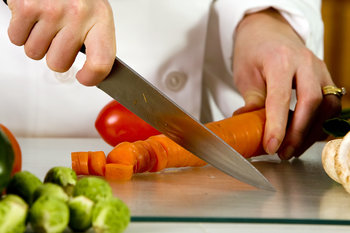 Knives are a practical and necessary tool in the culinary experience. Choosing the correct knife for the task starts with an understanding of the differnt types of knives and blades that are available. Proper use and care of your knives will ensure a long life for your sharpest cutlery and keep you from unfortunate kitchen injuries.
Knives are a practical and necessary tool in the culinary experience. Choosing the correct knife for the task starts with an understanding of the differnt types of knives and blades that are available. Proper use and care of your knives will ensure a long life for your sharpest cutlery and keep you from unfortunate kitchen injuries.
- Choosing the Right Knife for the Job
Using the right knife for each kitchen task is important—a knife that is too big or too small could result in a cut from too much force or over cutting, and a knife with the wrong edge for the task might mean a slip resulting in a cut.Knife Edges –
- Serrated (Wavy) Edge – This rough-edged blade is useful for cutting bread and other items with a tough crust and soft interior (sausage or tomatoes), catching the smooth surface and cutting without smashing in the process.
- Smooth (Straight) Edge – Best used for chopping or making precise cuts. This knife may be used for raw meat, vegetables and fruits and should be kept very sharp for the best cutting performance.
- Granton (Grooved) Edge – This knife is best used for slicing cooked meats or vegetables and has a “kullenschiff” edge that helps keep product slices from sticking to its edge.
Knife Types –
- Paring Knife – A small (3-4” blade) knife that allows intricate cutting, coring and trimming. Paring knife styles include Bird’s Beak, Chef’s, Sheep’s Foot, Wavy Edge and Clip Point.
- Utility Knife – A medium-sized blade (4-7”) and used for work too small for a chef’s knife.
- Boning Knife – A knife used for cutting meat from bones. A narrow knife would best be used for meat with a lot of bone and cartilage, like ribs and chops. A wide knife best cuts chicken and pork meats and a curved boning knife can be used for a better angle around bones.
- Chef’s Knife – a very large blade (6-12” long) used for fast cuts, chopping and slicing fruits and vegetables.
- Carving Knife – A knife with a long (8-14”), thin blade used for evenly slicing cooked meats.
- Bread Knife – A ridged (serrated) and long (8-9”) blade is perfect for bread and not much else.
- Cleavers – With a wide and thick blade, this knife is ideal for chopping through tough foods, including rinds and bones.
- Simple Knife Cleaning
Use mild dish soap and clean water to remove bacteria and food residue from your knives. Do not let your knives sit dirty or wet—they may rust. A dishwasher will damage knives (dulling and rust) and can also cause injury if a unsuspecting hand is caught on the sharp blade, so always hand wash your knives.Never allow your knives to soak in a sink of water or sit dirty in the sink—allowing a knife to lay out unattended may also result in an accidental cut. - Keeping a Sharp Edge
Many people might be surprised to know that a razor sharp knife is safer than a dull knife—dull knives require force that can easily result in a slip or surprise cut that can stab or slice a finger. Quality knives will hold a sharp edge longer than cheaper knives.Your knives should be sharpened about every 60 days if you use them on a frequent basis. - Properly Storing Your Knives
For safety reasons your knives should always be stored in a special place. Knife blocks or drawer inserts can easily hold your knives and keep them ready for use. A knife case or knife bag can be used if you need your knives to be mobile and ready to travel.
Visit Chef Works Cutlery to see a full line of professional knives and accessories.


